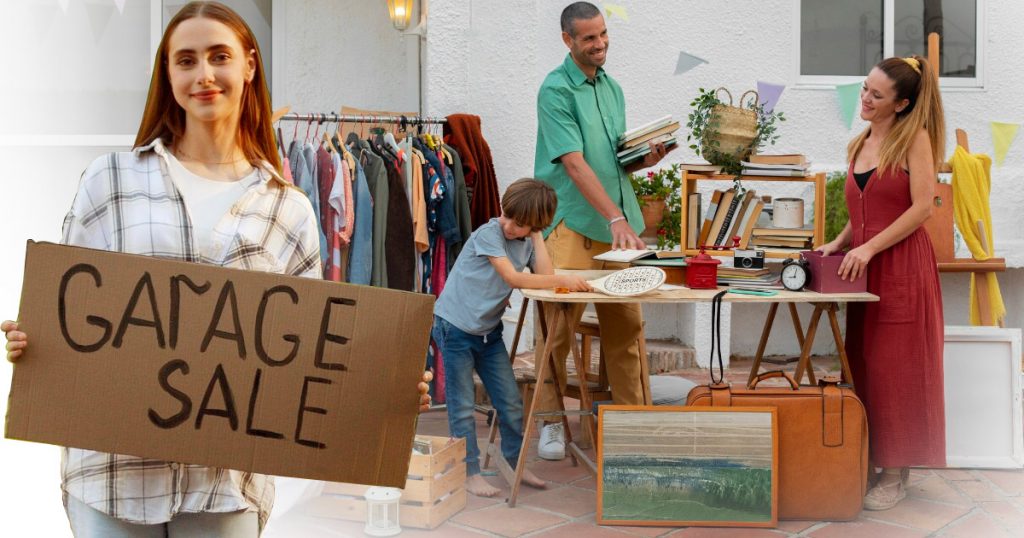Garage sales can help you clear out clutter and earn extra cash, but setting prices isn’t always easy. Some people overprice and end up stuck with everything. Others price too low and lose money. Finding the right balance matters if you want a successful sale.
If you’re not sure how to price garage sale items or want better results this time, these tips will help. You’ll learn how to price things for a garage sale with confidence, using real strategies that work.
1. Know Your Goal Before You Start Pricing
Decide what matters more to you: making money or getting rid of stuff.
If your main goal is to declutter, then you’ll want low prices that move items fast. If you’re aiming for profit, pricing should be closer to resale value. Either way, your goal will guide every pricing decision and help you stay consistent.
2. Price Based on Condition, Not Emotion
We often feel attached to things we own. That can make us price items based on memories instead of their real value. Try to be objective and focus on the item’s current condition.
Use this simple guideline:
- Excellent condition: around 50 percent of the original price
- Good condition: around 25 to 30 percent
- Fair or poor condition: around 10 percent or less
Even something branded won’t sell if it looks worn out.
3. Check Local Listings for Price References
Not sure how to price yard sale items like small appliances or tools? Check Facebook Marketplace or Craigslist. See what people charge for similar items near your area.
You can also browse thrift stores or consignment shops. Their pricing gives a good idea of what buyers expect to pay. Garage sale pricing should usually be a little lower since people often expect deals.
4. Keep Prices Simple and Easy to Understand
When pricing your stuff, stick with round numbers. Use amounts like 25 cents, 50 cents, one dollar, or five dollars. Avoid weird prices like $1.35 or $3.75. Buyers don’t want to do mental math or wait for exact change.
Use stickers or tags to mark every item. If people don’t see a price, many won’t bother asking; they’ll just move on.
5. Use Price Ranges That Make Sense
Different items fall into different price ranges. Here are some general guidelines to follow:
- Kids’ clothes: 25 cents to $2 per piece
- Adult clothes: $1 to $5, depending on brand
- Books: 50 cents to $2
- DVDs and CDs: 50 cents to $1
- Toys and puzzles: $1 to $5
- Kitchenware: $1 to $10
- Electronics: $5 to $30 (only if working)
- Furniture: $10 to $100, depending on size and condition
This helps you avoid overpricing and keeps everything within reasonable garage sale pricing expectations.
6. Bundle Similar Items to Encourage Bulk Buys
Bundling works well for smaller items. You can offer deals like five books for $5 or fill-a-bag clothing for $10. These small promotions motivate buyers to grab more without haggling over every item.
Grouping also makes your setup look more organized and easy to browse.
7. Leave Room for Haggling
Garage sale shoppers love to negotiate. Expect people to offer less than your asking price. If you want to sell something for $10, consider pricing it at $12 so you can accept a lower offer without losing value.
If you’re not open to offers on certain items, clearly mark them as “firm” or “no haggle.”
8. Adjust Prices as the Sale Goes On
If items aren’t selling, drop the price halfway through the day. As the sale wraps up, offer bigger discounts. Try something like “half off everything after 2 PM” to clear out what’s left.
You can also create a free box for damaged or unwanted items. This keeps buyers engaged and might bring in more foot traffic.
9. Make Items Look Worth the Price
Even cheap items need to look clean and cared for. Wipe down dusty electronics. Fold clothing neatly. Stack books in order. The better your setup looks, the more confident people will feel about buying.
If you’re selling electronics or appliances, have an extension cord nearby so buyers can test them. Trust builds faster when people see items working.
Let Your Prices Tell a Story
Garage sales are about passing your items on while earning some money. Each item once had a purpose in your life. With the right price, it gets the chance to mean something to someone else, too.
Fair pricing builds trust, sparks conversations, and creates small moments of connection with every buyer who stops by. When your items are priced with care, shoppers feel good about what they take home. And you’ll feel good knowing your clutter made someone’s day.

